
Through the art of blogging, you can publish engaging digital content on dedicated websites, reaching readers across the globe with regular updates.
From personal journals to business platforms, niche expertise to breaking news, blogs come in diverse forms that let you share knowledge while establishing credibility in your field.
Creating content brings personal satisfaction to 76% of bloggers, whether they’re writing for self-expression or professional growth.
Like me, many transform their platforms into revenue streams through affiliate partnerships and sponsored posts.
Blogging can become your digital asset that generates online income, with potential selling values ranging from thousands to millions of dollars.
Table of Contents
What is Blogging?
Blogging is the process of creating and publishing content online, such as articles, photos, and infographics. It involves sharing long-form articles on a specific subject, often in an informal or conversational style.
Blogging has transformed from simple personal online diaries in the late 1990s into a vibrant platform for individuals and organizations to share insights, expertise, and narratives through chronological web posts.
Blogs are frequently updated web pages that can be used for personal commentary or business content. They allow individuals and businesses to share ideas, expertise, and updates, fostering interaction with internet users and building an online presence.
A blog consists of a series of entries (blog posts) arranged in reverse chronological order. Blogging includes managing a blog, writing posts, promotion, and link-building.
Who is Blogger?
A blogger is a digital content creator who shares insights through regular posts on their blog. From dedicated hobbyists to seasoned professionals, their distinct voice emerges through consistent publishing, reader interaction, and active participation in blogging communities.
| Blogger Type | Primary Focus |
|---|---|
| Professional | Monetization |
| Hobby | Personal Expression |
| Expert | Industry Knowledge |
| Corporate | Business Growth |
Whether working independently or within established media organizations, these writers craft content across various fields, from tech insights to lifestyle advice and from financial guidance to travel chronicles.
To captivate their audience and establish domain expertise, successful bloggers skillfully weave together various media elements, including compelling text, striking visuals, and engaging video content.
Why Do People Blog?
You’ll find three main reasons why people choose to start blogging: personal expression, professional advancement, and community building.
Through personal blogging, you can share your thoughts, experiences, and creative work while maintaining a digital journal of your life’s journey.
Whether you’re growing your business brand, establishing yourself as an industry expert, or connecting with like-minded individuals in your niche, blogging provides a powerful platform for achieving your goals.
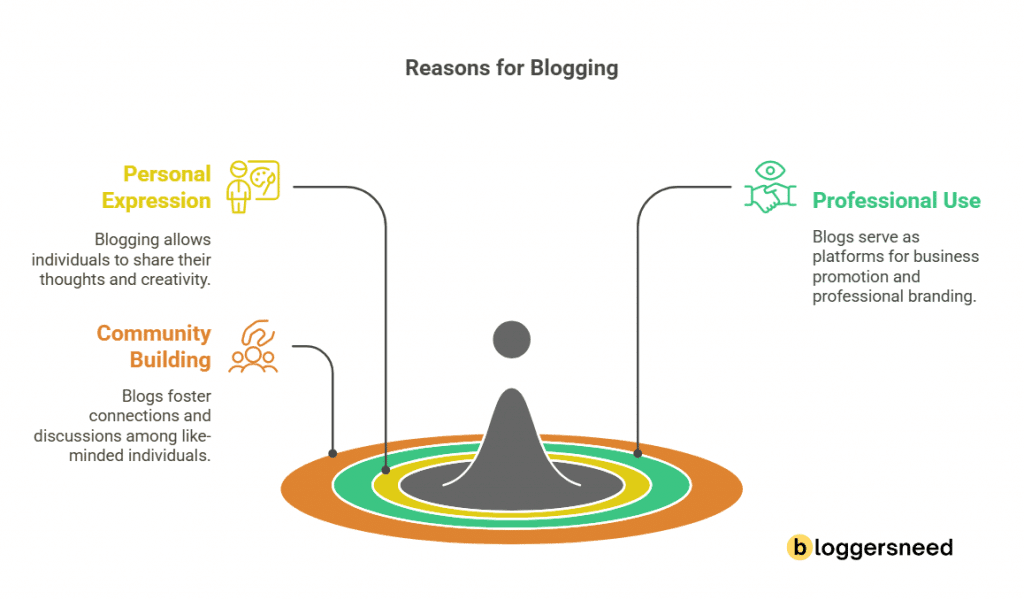
Personal Expression
Driven by the desire for self-expression, millions have ventured into blogging, with studies revealing that personal fulfillment motivates 76% of content creators. This digital medium serves as a powerful creative channel, enabling individuals to broadcast their unique worldview.
When bloggers share personal narratives, they forge meaningful connections with readers who relate to their experiences and share common interests.
Through a personal blog, you can:
- Chronicle life’s significant moments and achievements
- Showcase specialized knowledge and expertise
- Navigate complex emotions through reflective writing
- Foster global relationships with kindred spirits
- Cultivate an authentic writing voice
Operating much like digital diaries, personal blogs create spaces where ideas flow freely and genuine connections flourish among readers who deeply resonate with the shared content.
Professional/Business Use
Professional blogging transcends mere self-expression, delivering tangible business results – 77% of organizations report it as an effective source of customer leads.
To maximize your blog’s commercial potential, blend ethical practices with strategic brand narratives. From building industry credibility to boosting web traffic, nurturing client relationships, and driving sales, corporate blogs serve diverse business objectives.
Industry leaders like HubSpot and Salesforce illustrate the power of consistent blogging in elevating market presence and deepening customer connections.
Beyond immediate impact, professional blog content becomes a lasting business asset, continuously generating value and returns long after its initial publication.
Community Building
According to WordPress’s latest survey, fostering online communities motivates nearly 80 percent of bloggers.
Bloggers form authentic relationships with like-minded readers through engaging content and digital networking platforms.
To nurture these connections:
- Weekly Q&A sessions open direct channels between creator and audience
- Robust commenting platforms spark thoughtful exchanges
- Private membership spaces deliver premium content experiences
- Virtual gatherings strengthen real-time community bonds
- Curated social media groups extend conversations beyond the blog
What Are the Benefits of Blogging?
When you start blogging, you’ll discover multiple benefits that span personal growth, business development, and financial opportunities.
You can enhance your writing skills, build authority in your field, and connect with like-minded individuals through personal blogging, while businesses can attract customers, showcase expertise, and boost brand visibility.
Through various monetization methods such as affiliate marketing, sponsored content, and digital products, you’ll find opportunities to generate income from your blog.
For Individuals
Launching a personal blog can transform your professional trajectory while unlocking creative potential and expanding your network. Through consistent publishing and community engagement, you’ll master current digital trends and build a loyal readership.
By sharing in-depth insights from your field, you naturally position yourself as a trusted voice within your industry. A well-curated blog serves as a living portfolio, demonstrating your expertise to future employers and clients.
Beyond professional growth, blogging opens doors to monetization through affiliate partnerships and sponsored opportunities. The relationships you forge with fellow industry professionals often prove invaluable, leading to collaborations and career opportunities.
Meanwhile, maintaining an active blog sharpens essential skills – from crafting compelling narratives to optimizing content for search engines and executing digital marketing strategies.
Your blog ultimately becomes more than a website; it evolves into a dynamic personal brand asset that fuels career growth while fostering continuous professional development.
For Businesses
Through strategic blogging, businesses can achieve tangible ROI by increasing web traffic, generating leads, and building customer trust. Companies that maintain active blogs typically see 67% more leads than their competitors who don’t blog – making it a powerful tool for establishing industry authority.
A well-planned content strategy transforms your blog into a valuable resource library. By addressing customer pain points, exploring industry developments, and sharing product knowledge, you’ll naturally improve search visibility while positioning your brand as a trusted voice in your field.
Beyond marketing metrics, your blog serves as a dynamic communication platform. Whether announcing company milestones, showcasing product innovations, or sharing expert perspectives, it deepens connections with current customers while drawing in potential clients through organic engagement.
Monetization Opportunities
From display advertising to premium subscriptions, savvy bloggers harness diverse income streams to generate substantial earnings.
Top bloggers make $50,000 to $100,000 monthly by strategically monetizing their websites.
By implementing proven strategies carefully, your blog can become a steady source of passive income while maintaining authentic reader connections.
Consider these monetization channels:
- Strategic placement of ads via platforms like Google AdSense or Mediavine
- Curated affiliate partnerships with brands that align with your niche
- Creation and distribution of digital products, from online courses to downloadable templates
- Thoughtfully crafted sponsored content with select industry collaborators
- Exclusive membership programs offering premium content access
What Types of Blogs Do Bloggers Use?
Today’s bloggers can choose from five distinct types of blogs to share their content: personal blogs, business blogs, niche blogs, news blogs, and educational blogs.
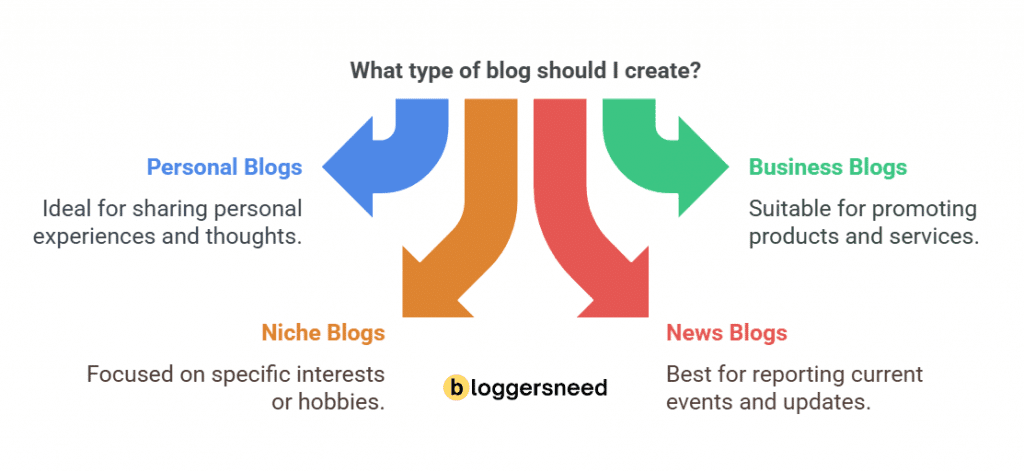
Personal Blogs
Personal blogs are friendly digital platforms where individuals share their unique experiences, thoughts, and stories, connecting with a global audience effectively.
As personal blogger they write about their daily life, wanderlust adventures, and family moments through thoughtful reflections and hard-won wisdom.
Listed below are the Key aspects of personal blogging.
- Raw, genuine sharing of personal journeys and feelings
- Preservation of life’s defining moments and cherished memories
- Authentic engagement with readers through shared experiences
- Creative expression across diverse writing formats
- Development of tight-knit communities united by common interests
Business Blogs
Business blogs have emerged as powerful strategic tools in the digital marketing landscape, enabling companies to build brand recognition, showcase expertise, and attract qualified prospects.
Creating a successful blog demands thoughtful planning and execution. First, define your ideal audience segments. Then, develop content that directly addresses their challenges and interests. Meanwhile, incorporate proven SEO techniques to increase visibility.
Popular platforms like WordPress simplify content management, while tools such as HubSpot and Google Analytics provide crucial performance data.
From detailed product announcements to comprehensive how-to articles, your blog can take many forms. Share industry analysis that positions your brand as a thought leader. Present compelling case studies demonstrating real results.
Most importantly, focus on delivering consistent value through well-crafted content that resonates with readers and nurtures lasting customer relationships.
Niche Blogs
Niche blogs publish articles within specific categories. If you’re planning to create a niche blog, avoid highly competitive niches dominated by well-established sites.
In 2025, top authoritative blogs rank at the top of the SERPs. To establish authority, you must have expertise in your chosen niche, as there is a lot of competition.
When you search for camera drones on Google, authoritative sites like Amazon and Best Buy rank in the top positions.
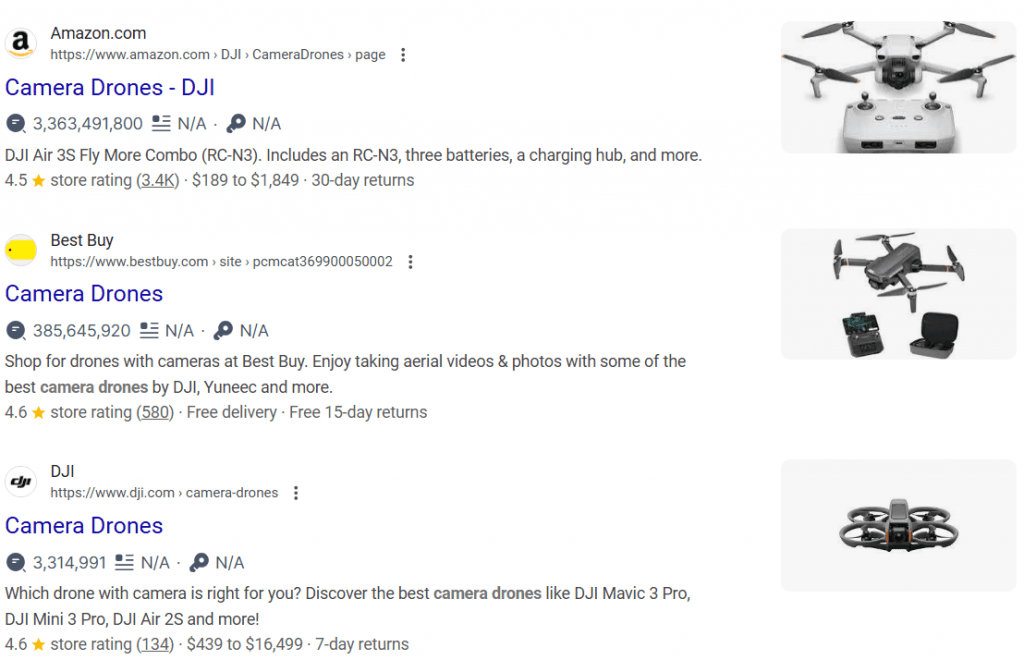
Data reveals that niche-focused blogs generate triple the engagement of their general-topic counterparts. When you craft content for a defined reader demographic, it naturally aligns with their distinct interests and needs.
Listed below are the popular blog niches.
- Health and wellness (fitness, nutrition, mental health)
- Personal finance (investing, budgeting, retirement)
- Technology (software reviews, gadgets, coding)
- Lifestyle (travel, fashion, home decor)
- Education (online courses, study techniques, career development)
For optimal results, select a niche where your expertise intersects with strong market demand.
News Blogs
Digital news blogs revolutionize information delivery by offering real-time coverage, detailed analysis, and comprehensive reporting on topics ranging from politics to technology.
Through constant updates and live reporting, readers gain access to thorough examinations of emerging trends and breaking developments.
| Feature | Purpose | Impact |
|---|---|---|
| Breaking News | Swift Event Coverage | Instantaneous Information Flow |
| Analysis | Comprehensive Understanding | Enhanced Reader Awareness |
| Commentary | Specialized Insights | Deeper Topic Mastery |
| Fact-checking | Information Validation | Credibility Enhancement |
Educational Blogs
From simple tutorials to comprehensive lesson plans, educational blogs have revolutionized digital learning by connecting educators, experts, and institutions across countless subjects – from mathematics and science to languages and professional growth.
These dynamic platforms transform conventional teaching methods through rich multimedia content, targeted assessment tools, and collaborative spaces where knowledge flows freely between instructors and learners.
At their core, educational blogs offer:
- Intuitive tutorials enriched with visual guides
- Ready-to-use classroom materials and curriculum resources
- Engaging activities from quizzes to educational gaming
- Evidence-based instructional frameworks
- Practical solutions for classroom dynamics and student motivation
How to Start a Blog?
To start a blog you must choose popular content management system like WordPress, Wix, and Medium.
At BloggersNeed, we’ve already written an article about how to start a WordPress blog with easy steps.
In general there are seven steps to start a blog.
| Step | Action | Timeline |
|---|---|---|
| 1 | Choose Platform | Day 1 |
| 2 | Select Domain | Day 1-2 |
| 3 | Set Up Hosting | Day 2-3 |
| 4 | Set Up Theme and Install Plugins | Day 2-3 |
| 5 | Research Topics | Day 3-5 |
| 6 | Write content | Day 5-7 |
| 7 | Publish content | Day 7 |
After launching your blog, regularly publish well-researched content that follows on-page SEO strategies and build authority through link-building techniques like guest posting, link placement, and blog commenting.
Following these SEO strategies from day one ensures your content ranks in top positions and attracts a global audience.
How to Write Your First Blog Post?
Writing your first blog post starts with generating relevant topic ideas through brainstorming and analyzing your target audience’s interests.
You’ll need to conduct thorough keyword research using tools like Google Keyword Planner or Semrush to identify search terms your potential readers are using.
The final steps involve crafting engaging content with proper headings, subheadings, and optimizing your post with meta descriptions, alt tags, and relevant internal links to enhance its search engine visibility.
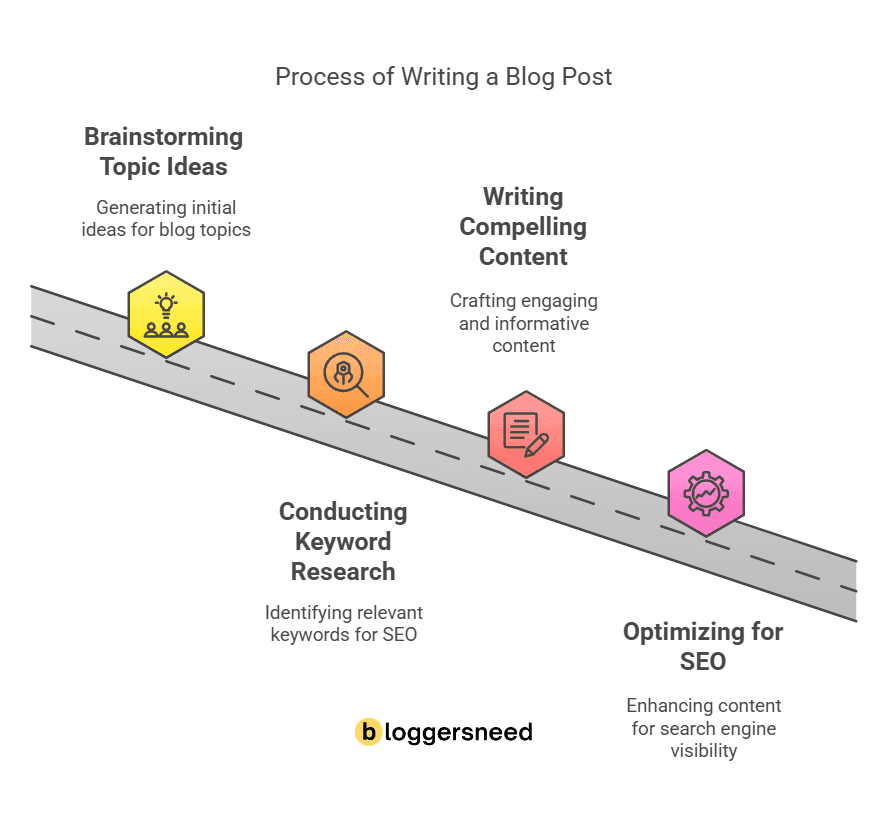
Brainstorming Topic Ideas
Need a killer topic for your first blog post? Start by ensuring it captivates your target audience while serving your blog’s core mission.
Through creative brainstorming, you’ll uncover ideas that genuinely matter to your readers and fill knowledge gaps in your niche.
Topic generation doesn’t have to be overwhelming. Start with these proven techniques:
- Let your ideas flow freely through mind mapping exercises.
- Track what’s hot in your field using Google Trends data.
- Connect directly with potential readers to understand their struggles.
- Study your competitors’ content to spot untapped opportunities.
- Map out seasonal themes that align with your readers’ interests.
If you already have a topic, you can use AI blog idea generators like HubSpot.
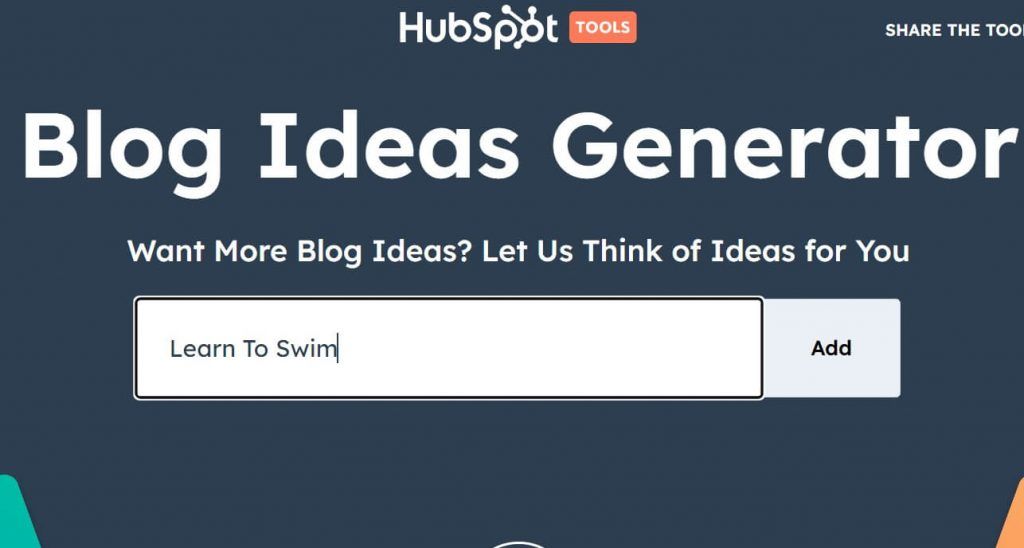
This organic approach to topic development helps ensure your content stays fresh and purposeful.
Conducting Keyword Research
Thorough keyword research is essential to boost your content’s visibility after selecting a blog topic. By using professional tools and analyzing competitors, you can discover the exact search terms your target audience uses.
| Research Step | Action Required |
|---|---|
| Primary Keywords | Identify main topic terms |
| Secondary Keywords | Find related phrases |
| Search Volume | Check monthly searches |
| Difficulty Score | Assess ranking potential |
Success often lies in targeting long-tail keywords – specific phrases with lower competition but definitive search intent.
While beginners can start with free platforms like Google Keyword Planner and Ubersuggest for basic data, serious content creators might invest in premium SEO tools such as SEMrush or Ahrefs to gain comprehensive keyword insights and competitive intelligence.
Writing Compelling Content
Creating engaging content begins with comprehensive keyword research, but true effectiveness is achieved by crafting posts that resonate with your audience and satisfy their search intent.
By focusing on effective writing techniques that prioritize reader engagement, you can produce high-quality content that drives traffic and boosts conversions.
Essential elements of compelling content include:
- Strategic organization with clear headings and subheadings
- Credible support through relevant statistics, data points, and expert insights
- Short paragraphs with simple English, understandable by a 4th grader.
- Engaging visual components such as custom images and informative graphics
- Purposeful conclusions featuring clear, action-oriented next steps
Through this approach, your content will effectively serve readers while advancing your blogging future.
Optimizing for SEO
The foundation of effective blog visibility rests on three pillars: strategic keyword placement, meta-tag optimization, and well-planned content architecture.
To improve your blog’s search performance, focus on integrating relevant keywords seamlessly into your titles, headings, and body content.
Start strong by incorporating target phrases within the opening paragraph, specifically the first 100-150 words.
Craft compelling meta elements that serve both readers and search engines: concise titles (50-60 characters) paired with informative descriptions (150-160 characters). Each should feature your primary keywords while accurately previewing the content.
Build a clear content hierarchy using H1-H6 headings strategically, and maintain optimal keyword frequency at 1-2% throughout your post.

What Are the Best Strategies to Promote a Blog?
Promoting your blog effectively requires implementing multiple proven marketing strategies that work together synergistically.
You’ll need to leverage key promotional channels including social media platforms (Facebook, Twitter, Instagram), email newsletters, guest posting opportunities on established blogs, and search engine optimization techniques.
These strategies, when executed consistently, can help increase your blog’s visibility, drive targeted traffic, and build a loyal readership base through systematic promotion across various digital platforms.
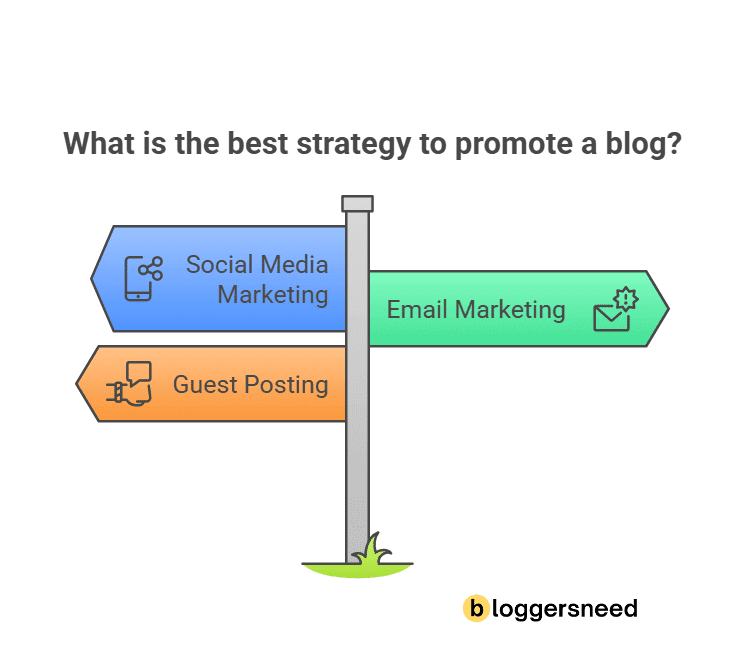
Social Media Marketing
To effectively expand your blog’s reach and build meaningful connections with your audience, it is crucial to use social media platforms such as Facebook, Instagram, Twitter, and LinkedIn.
While each platform demands unique content approaches, the core principles of effective social media marketing revolve around strategic timing, authentic engagement, and data-driven optimization.
- Tailor your content format to each platform’s strengths: eye-catching visuals for Instagram, thought-provoking threads for Twitter
- Time your posts strategically by analyzing when your audience is most active
- Amplify content discovery through carefully selected hashtags
- Build community through interactive elements: respond to comments, launch polls, initiate conversations
- Let performance metrics guide your strategy: monitor reach, engagement rates, and conversion data
Email Marketing
Email marketing remains a powerhouse among blog promotion strategies, yielding an impressive $42 return for each dollar invested.
Through strategic segmentation, you can boost audience engagement by organizing subscribers into targeted groups according to their demographics, online behavior, and personal interests.
Popular email marketing platforms like MailChimp and ConvertKit offer robust automation features that simplify content scheduling while providing detailed performance analytics.
Building lasting connections with your audience requires thoughtful email sequences – from warm welcome messages to curated content digests and member-exclusive promotions.
When campaigns fall short of expectations, analyzing metrics such as open rates, click-throughs, and conversions will help fine-tune your marketing approach.
Guest Posting
Guest posting is one of the best ways to increase E-E-A-T, and Google favors blogs that demonstrate authoritativeness and trustworthiness.
When done right, guest posts not only showcase your expertise but also generate valuable backlinks to boost your site’s authority
To start your guest blogging journey, utilize SEO tools to identify top blogs in your niche, focusing on their domain authority and monthly visitor counts.
Craft individualized outreach emails that clearly explain why you would be an ideal contributor.
When your proposal is accepted, use your expertise to create valuable content that deeply connects with the host site’s community.
Your author bio deserves special attention – make it compelling while incorporating strategic links to your own platform.
Success in guest blogging hinges on relationship building, so maintain professional communication and nurture connections that could lead to recurring opportunities.
What Are the Best Tips for Successful Blogging?
Here are some bloggers tips to achieve success in blogging, you’ll need to focus on creating high-quality, valuable content that addresses your audience’s specific needs and interests.
You can build a loyal following by consistently engaging with your readers through comments, social media, and email newsletters while also networking with other bloggers in your niche.
Your blog’s visibility will improve markedly when you implement effective SEO practices, such as using relevant keywords, optimizing meta descriptions, and creating internal links between your posts.
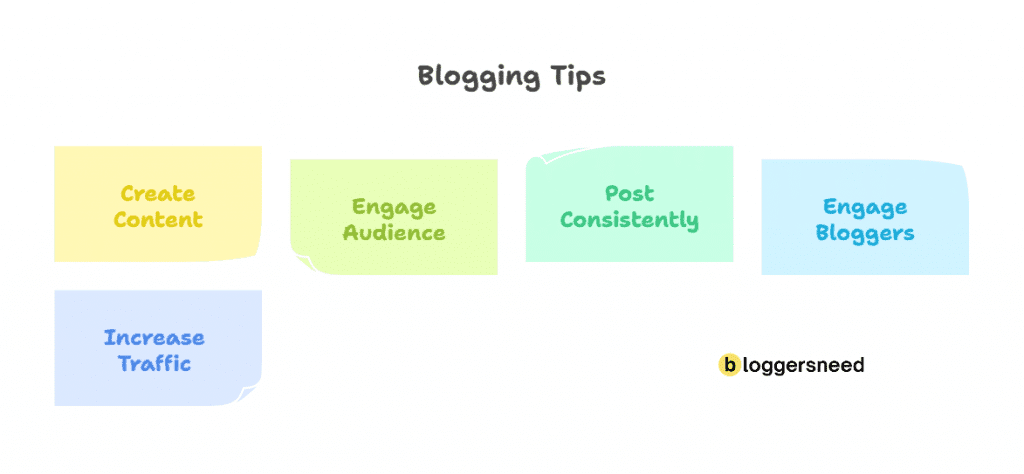
Create Best Content
Creating exceptional blog posts demands more than just good writing – it requires mastering several key elements that drive successful content creation.
Through strategic brainstorming and deep audience understanding, you’ll uncover topics that not only connect with readers but also maintain relevance within your specific niche.
To develop high-quality content:
- Use AI to dig deep with comprehensive research from authoritative sources and up-to-date data
- Build a logical framework using clear headings and subheadings
- Strengthen your arguments with compelling examples, case studies, and relevant statistics
- Break text into digestible chunks while using engaging formatting techniques
- Insert targeted keywords naturally into conversational prose
When implemented thoughtfully, these strategies will help your content deliver genuine value, build lasting credibility, and foster meaningful engagement with your intended audience.
Engage with Audience
Engaging with your blog’s audience through timely responses to comments, social media interactions, and email newsletters promotes genuine connections and values their insights.
Analytics tools are essential for understanding audience engagement patterns. By analyzing metrics like comment activity, content sharing, and page retention times, you can identify the topics that connect most with your community.
A structured approach to reader interaction, including 24-hour response windows for comments and messages, helps maintain consistent communication standards.
To deepen audience involvement, consider hosting dedicated Q&A sessions while deploying strategic polls and surveys.
Each blog post should conclude with thoughtful calls-to-action that encourage readers to contribute their experiences or raise questions, creating opportunities for richer discussions.
Post Content Consistently
Consistency in posting builds a strong foundation for your blog and keeps your audience engaged. By developing a content calendar, you’ll streamline the planning, organization, and execution of your publishing schedule.
The ideal posting frequency varies by niche and should align with your audience’s engagement patterns.
Success depends on several key practices:
- Lock in specific publishing times – whether daily, weekly, or monthly
- Map upcoming topics with content planning tools
- Build a reserve of ready-to-publish pieces for unexpected gaps
- Monitor analytics to pinpoint when readers are most active
- Establish attainable goals that match your time and resources
Engage With Other Bloggers
Building powerful connections within the blogging community is essential for expanding your reach and establishing industry expertise.
Dive into meaningful engagement by leaving thoughtful comments on peers’ posts, amplifying their content across your channels, and collaborating on initiatives from guest posts to dynamic webinars.
Network expansion happens both online and offline – consider industry conferences, local meetups, and virtual workshops as prime opportunities to forge relationships with seasoned experts and rising voices alike.
Professional communities on LinkedIn and Facebook serve as valuable hubs where you can contribute to discussions, showcase your knowledge, and track emerging trends in your field.
As these relationships deepen, they naturally evolve into mutually beneficial partnerships, creating opportunities for backlink sharing and enhanced blog visibility across multiple platforms.
Increase Website Traffic through SEO
Through strategic SEO practices, your content’s visibility can grow exponentially, while meaningful connections with bloggers help extend your reach. The key to attracting organic search traffic lies in implementing smart keyword optimization techniques alongside content that genuinely serves user needs.
Essential SEO practices include:
- Identifying and targeting keywords with sustainable search volume
- Crafting compelling meta titles, descriptions, and headers
- Developing comprehensive, in-depth content
- Cultivating authoritative backlinks
- Publishing fresh content on a regular schedule
Your SEO strategy should incorporate proper heading hierarchy and thoughtful internal linking. Ensuring mobile responsiveness remains crucial for modern websites.
Keep tabs on your optimization efforts through analytics platforms, which will reveal areas for improvement and guide strategic adjustments.
How to Make Money With Blogging?
Through blogging, you can make money online using multiple proven monetization methods.
The most common revenue streams include displaying advertisements through platforms like Google AdSense, promoting affiliate products from companies like Amazon, and selling your own digital products such as courses or ebooks.
Your blog can also generate income through offering consulting services or creating premium membership programs with exclusive content and benefits.
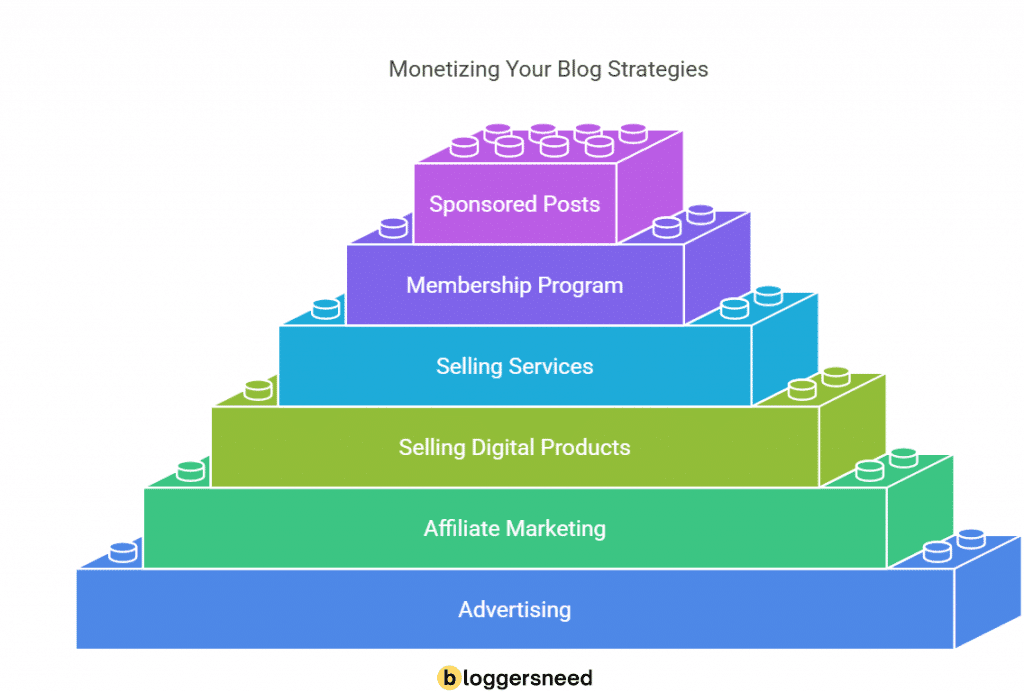
Advertising
Once your blog attracts consistent search engine traffic, monetizing it through advertising becomes a viable strategy.
The modern advertising landscape offers various revenue opportunities, including traditional display ads and innovative digital sponsorships, each providing unique ways to generate income from your platform.
Key advertising channels include:
- Google AdSense’s automated ad placement system
- Direct banner sales to relevant brands
- Affiliate partnerships with commission structures
- Brand collaborations through sponsored posts
To optimize revenue while preserving user experience, thoughtfully integrate these advertising elements across your blog.
Should your traffic metrics prove robust, consider deploying multiple formats simultaneously to create a diversified income portfolio.
Affiliate Marketing
Bloggers should learn affiliate marketing to monetize their blogs, as it is one of the best ways to earn commissions by promoting products and services through unique tracking links, contributing to an impressive annual revenue of over $8.2 billion in digital sales.
Successful affiliate content takes many forms, from in-depth product reviews to comparison guides and tutorials that seamlessly incorporate tracking links. When marketers prioritize transparency and authentic recommendations, conversion rates soar by 37%.
Building a profitable affiliate program requires careful consideration of several factors: choosing products that resonate with your blog’s audience, developing high-value content around these offerings, and diligently monitoring key metrics such as click-through and conversion rates.
Selling Digital Products
Digital products have emerged as a goldmine for bloggers, with the global market reaching $331.9 billion in 2023.
Success begins when you pinpoint solutions that address your audience’s specific pain points. By mastering online sales techniques, you’ll transform downloadable items into streams of passive income.
Popular digital offerings include:
- Niche-focused eBooks and comprehensive PDF guides
- In-depth online courses paired with video instruction
- Ready-to-use templates and printable resources
- Premium content housed within membership platforms
- Custom software solutions and mobile apps
To maximize revenue potential, craft sophisticated email marketing campaigns and strategic sales funnels.
A seamless purchasing experience depends on robust payment processing and reliable delivery systems that protect both seller and buyer.
Selling Services
Beyond their core content creation, professional bloggers can tap into profitable revenue streams by monetizing their expertise through specialized services.
While blog posts establish authority, strategic service offerings transform that influence into tangible business opportunities.
| Service Type | Description |
|---|---|
| Consulting | One-on-one expert guidance |
| Coaching | Personalized mentoring sessions |
| Speaking | Industry events and workshops |
| Writing | Custom content creation |
| Training | Group educational programs |
To maximize service-based income, weave offerings naturally throughout your blog’s ecosystem.
This might include crafting dedicated service pages that outline clear value propositions, integrating relevant case studies within your content, and highlighting client success stories.
When potential clients stumble (upon) both your expertise through content and proof of results through testimonials, they’re more likely to invest in your services.
Creating a Membership Program
A passive revenue stream awaits bloggers who complement their free content with paid membership programs offering exclusive value to subscribers.
Through thoughtfully structured tiers, you can deliver specialized content and unique experiences that reward your most loyal followers.
Consider this tiered approach:
- Basic, Premium, and VIP levels, each with escalating benefits
- Exclusive deep-dive tutorials, downloadable templates, and detailed case studies
- Interactive experiences via members-only webinars and live Q&A sessions
- Access to private networking communities
- Personal consultation opportunities at premium tiers
Begin with an entry-level membership option to refine your content strategy and incorporate member feedback before expanding into more comprehensive offerings.
Sponsored Posts and Reviews
Partnering with relevant brands and businesses through sponsored content can become a profitable revenue stream once your blog attracts a steady readership.
Successful sponsored content requires a multi-faceted approach: transparent disclosure of brand relationships, genuine product endorsements, and strategic selection of partnerships that resonate with your blog’s focus.
When reviewing products, maintain ethical standards by openly acknowledging any compensation while providing unbiased assessments.
Sponsored posts typically command rates between $250 and $2,000, with pricing variables including your site’s traffic volume, audience engagement, and subject matter expertise.
Creating engaging content that seamlessly integrates promotional aspects into your narrative is essential for maintaining editorial integrity through genuine, balanced reviews.
What Are the Top Blogging Platforms?
Choosing the right content management system (CMS) is crucial for successful blogging, as it influences your ability to manage content, customize designs, and monetize your blog effectively.
Top bloggers prefer these leading blogging platforms.
- WordPress.org stands out as a self-hosted solution, offering unparalleled control and customization options.
- WordPress.com delivers a managed experience with hosting and maintenance included.
- Medium attracts professional writers with its focus on high-quality content distribution.
- Wix empowers users through intuitive drag-and-drop website building tools.
- Squarespace combines striking design templates with robust e-commerce capabilities.
Who Are the Top Bloggers, and How Much Do They Earn?
Here are the top bloggers who earn millions per year by leveraging multiple monetization strategies to maximize their income.
- Neil Patel: Neil Patel, renowned digital marketing expert and founder of NeilPatel.com, earns $380,000 per month through his expertise in SEO and content marketing.
- Syed Balkhi: WPBeginner founder and founder of a variety of web ventures, Syed Balkhi accumulated a $100M empire before age 30 with focused content and SaaS tools.
- Pat Flynn: Pat Flynn, founder of Smart Passive Income, is well known for his open financial reports and expertise in affiliate marketing, generating $200,000 monthly through course creation, affiliate commission and podcasting.
- Michelle Schroeder-Gardner: She is the creator of Making Sense of Cents, and she built her personal finance blog into a $1.5 million a year business. She writes about living a nomadic lifestyle and financial planning .
- Tim Ferriss: A lifestyle entrepreneur pioneer, Tim Ferriss has motivated millions with his book The 4-Hour Workweek and podcast The Tim Ferriss Show, in which he interviews people on their productivity and success strategies.
Through diverse revenue streams, these bloggers have built remarkable income portfolios. While media giants like HuffPost command over $500 million annually.
How Can Bloggers Maintain Physical Fitness?
While professional bloggers typically log 6-8 hours at their desks daily, maintaining physical wellness proves essential for both health and productivity.
A well-designed ergonomic workspace, complete with proper posture support and accessible nutritious snacks, enables sustained energy throughout long work sessions.
Key practices include:
- Regular movement breaks: 5 minutes of stretching every 50 minutes
- Alternating between sitting and standing: Utilize a standing desk for 2-3 hours
- Consistent hydration: Keep water nearby and consume 8 glasses throughout the day
- Eye care routine: Follow the 20-20-20 rule by focusing on distant objects
- Desk-based exercises: Incorporate shoulder rolls and wrist stretches hourly
The modified text varies sentence structure through different openings, embedded clauses, and diverse punctuation while preserving the original message about workplace health habits.
Affiliate Disclosure: Some of the links in this post are affiliate links, which means I may earn a small commission if you make a purchase through those links. This comes at no extra cost to you. Thank you for your support!
